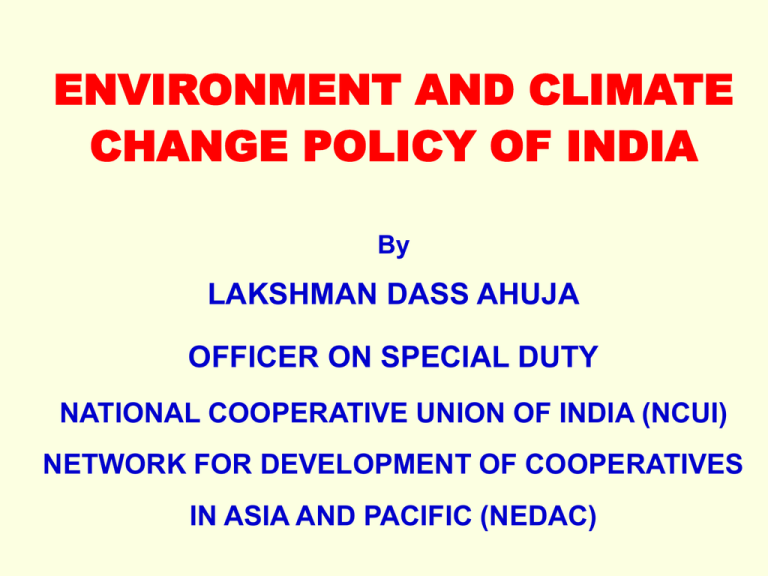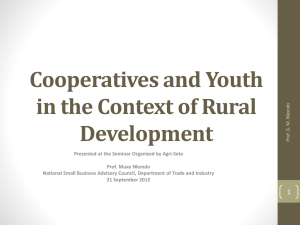Environment and Climate Change Policy of India
advertisement

ENVIRONMENT AND CLIMATE CHANGE POLICY OF INDIA By LAKSHMAN DASS AHUJA OFFICER ON SPECIAL DUTY NATIONAL COOPERATIVE UNION OF INDIA (NCUI) NETWORK FOR DEVELOPMENT OF COOPERATIVES IN ASIA AND PACIFIC (NEDAC) THE CHALLENGE OF CLIMATE CHANGE Climate change is primarily caused by building up of green house gases (GHG) e.g. Carbon Dioxide, Methane, Nitrous Oxide etc. in the atmosphere. Global increases in carbon dioxide concentration are due to fossil fuel, land use change and human activity Methane and nitrous oxide due to agriculture activity 2 THE CHALLENGE OF CLIMATE CHANGE Climate change is accompanied by : High average temperature Changed rainfall patterns Increased severity and frequency of floods, droughts and cyclones Oceanic acidification 3 CLIMATE CHANGE DUE TO GHGs Transport Industries Agricultural waste decay By birds, animals High yielding techniques of agriculture Arbitrary use of natural resources Deforestation Reduction in pastures Fertility of land reduction Forests, flora and fauna disappearance 4 OVERALL IMPACT ON Livelihoods of poor in developing countries Availability of water Food production / food security Flooding of coastal areas Increased burden of vector borne and water borne diseases Slows down the pace of development 5 INDIA’s VULNERABILITY TO CLIMATE CHANGE Is facing high degree of climate variability GDP growth is attributable to yearly variations in rainfall. Himalayan eco-system is now highly vulnerable Increases in mean sea levels will affect large populations in peninsular and coastal India. Gangotri Glacier - one of the largest is retreating Rainfall in India may increase by 15 to 40% and annual mean temperature by 3 to 6 degree. India may suffer huge losses to livelihoods. Agriculture sector would be most affected 6 IMPACT ON AGRICULTURE Agriculture 4 objectives 1. Resources conservation 2. Ecologic health 3. Economic gains 4. Social and Economic parity All are affected in varying degrees. Effect on production and productivity Production would be severely compromised Yields of crops like wheat, rice and pulses will go down Badly affects Horticulture crops Milk production to come down Fish exodus 7 IMPACT ON AGRICULTURE Affects food security Major challenges for food self sufficiency and affects global food security Changed precipitation – insect pressure – requires use of more and different pesticides 8 INDIA PART OF GLOBAL REGIME UN Framework on Climate change 1992 to stabilise green house gas concentration Bali Action Plan 2007 – long term cooperative action Kyoto Protocol and Copenhagen Conference 2009 – laid down emission reduction targets for industrialised countries Differences surfaced on several critical issues. Awaiting settlement in Mexico November – December 2010. 9 INDIA’s ACTIONS ON CLIMATE CHANGE 10 India’s total Co2 emissions are about 4% of global emission. % USA 19.8 China Russia 17.7 5.2 India 4.7 Japan Germany Canada 4.1 2.6 2.1 U.K. South Korea 2.0 1.6 Mexico 1.5 All other Countries Total 38.8 100 11 Decoupling of growth of emission from economic development- common but differential responsibilities and respective capabilities. Not binding on India. Economic, social and poverty reduction priorities. Mitigation in the context of sustainable development and consistant with National priorities. India’s per capita emission in next 20 years is going to be less than developing countries average. PM – India will never allow to increase per capita emissions to exceed that of the developing countries National Action Plan – maintaining a high degree of growth and reducing their vulnerability of the impact of climate change 12 EIGHT MISSIONS National Solar Mission National Mission on Enhanced Energy Efficiency National Mission on Sustainable Habitat National Water Mission National Mission for sustaining the Himalayan Eco-System National Mission for Green India National Mission for Sustainable Agriculture National Mission for Strategic Knowledge about Climate Change. 13 Besides, outlining 24 initiatives aimed at promoting technologies and actions in the sectors relating to Energy generation Transport Renewable energy Disaster management Capacity building Mission integration with Ministries and State Action Plans India prepares periodically the National Communication that gives inventory of green house gasses emissions etc. 14 CLEAN DEVELOPMENT MECHANISM Emission reduction Sustainable development Purchase of Carbon Reduction Certificates from developing countries India CDM potential significant part of the global market. India has 482 CDM Projects – 23% of the world. Institutional Mechanism A Council under Prime Minister 15 CARBON TRADING Emission of GHGs – Co2 is the major cause of global warming and climate change- human induced activities are spreading this Carbon footprint is a measure of impact that human activities have on the environment. It is measured in units of Co2 Reduction in emission can be achieved by industries by Using renewable energy and low carbon technology – wind energy, solar cells and bio-fuels, use of bio-mass Adopting energy efficient technology – use of energy efficient lamps Greening Efforts – planting of trees, converting waste land into plantation areas Adopting recycling and use of recycled products – co-processing waste material, agro waste like rice husk, bagasse etc. Teleconferencing instead of flying Green buildings Results in sustainable development, cost savings, environment sensitive market, higher profits, reduction 16in direct risks like floods, drought and supply chain risk etc. COPING WITH CHANGE Coastal zone Buildings and construction Transport Water supply in arid areas Making India energy efficient Agriculture Bio-diversity management Barren Land use planning Check dams Health Rescue Preparedness Insurance Aspect Need for agriculture productivity increase, animals, fishery and forests, need for crops which retain the fertility of soil.17 INITIATED STEPS IN AGRICULTURE Ministries of Agriculture and Environment have taken many steps Organic farming and green agriculture are environment friendly. This is being done. Green agriculture is based on integrated pest and nutrient management crop livestock integration, use of most appropriate and productive genetic strains and adoption of more crop and income per drop of water technologies. A bio-diversity valley in Orissa is established. 18 INITIATED STEPS IN AGRICULTURE Generation of electricity and bio-manure through Waste Management Bio-fertiliser Compost Vermiculture Bio-mass briquettes - Gassifier based grid power programme - conversion of solid bio-mass (wood, agriculture residue) into combustible gas 19 STEPS BY COOPERATIVES 20 86th ICA DAY – JULY 2008 ON CLIMATE CHANGE Cutting green house gas emission Carbon neutrality – agriculture and fishery cooperatives – stress on green energy production or innovative feed to reduce emission from livestock production Consumer cooperatives – carbon footprints - reduction in stores operations, supplies, education to members Housing –sustainable construction material, eco-buildings Cooperative banks/ credit - incentives for energy efficient technology 21 86th ICA DAY – JULY 2008 ON CLIMATE CHANGE Insurance cooperatives – down premiums – more risk coverage Energy cooperatives – sustainable energy through wind, solar and bio-fuels Economic, social and environmental sustainability Cooperative assume leadership Environment Programme ICA reaffirmed its commitment role – with UN sustainable development and contributing substantially to mitigate the effects of climate change 22 COOP CONNECT MEETING BY NCUI ON CLIMATE CHANGE Community based and people centric organisations, eminently suited for spreading the message Cooperatives - hardly any dialogue with Government Huge infrastructure of education and training – one session - special programme Care for Climate – cooperative principle Forestry and Jatorpha Cooperatives, Tree Growers Cooperatives IFFCO and KRIBHCO – commendable work 23 COOP CONNECT MEETING BY NCUI ON CLIMATE CHANGE Showcase best practices Global Network Carbon, water, fodder, inputs and knowledge banks Formulate a Strategy that is environmentally, socially, economically and politically sustainable. NCUI facilitation CDM Awareness Co2 24 KRIBHCO, IFFCO recognised for environment protection, energy conservation, tree plantation, bio-gas, vermicompost. IFFCO sold carbon credit worth Rs. 400 million to Spain Dairy – Tree grower Cooperatives in Gujarat Re-cycling of milk pouches, Solar water heater, sugar-power co-generation, efficient water treatment, recycling of effluent water, ethanol production, afforestation, bye-product industries Cooperatives – grass root level can collect traditional wisdom and disseminate 25 A Community Project in 9 Tribal districts of M.P is being taken up. Features are Education of rural masses Growing role of Gram Sabha Code for collective action Saving water Caring for plantations Fields chemical free Rational energy consumption Conservation of flora and fauna Information to families how to mitigate carbon emissions Stress on indigenous methods or modern one like bio-gas plants, solar energy, sharing of indigenous knowledge Such projects need to be taken up by Cooperatives 26 ECOLOGICAL CODE Land Energy Water Waste Air Carbon – - Awareness- Bio-diversity enhancement Green Energy Efficiency Effective Waste Water Management Waste Management Reduce air pollutants Cut emissions through energy efficiency initiatives Create awareness 27 CORPORATE SECTOR Involvement of communities, CSOs and Corporates Countering Climate Change Attractive incentives – task breaks Lower tariffs R and D grants Persuade industries to go green Penalties those who violate energy efficiency solutions 28 CORPORATE SECTOR Village watershed committees managed by communities Development versus Environment debate Coping carbon emission would slow down growth Growth only way out of poverty Need for development of clean technology Create awareness and share knowledge of best practices Unfortunately environment is still a fringe issue 29 FOOD SECURITY AND COOPERATIVES IN INDIA • • • • Cooperative Societies Acts, 1904 and 1912 Movement more than 100 years old. 6 lakh cooperatives and 250 million members. Membership consists of small and marginal farmers, landless labourers, womenfolk, scheduled caste and tribes, educated unemployed youth, handloom weavers, fishermen, poultry and dairy farmers. • Democratically managed. • Practices internationally recognised cooperative principles. • Played pivotal role in ushering in Green and White Revolutions – poised for Evergreen, Blue and Yellow Revolutions 30 SHARE OF COOPERATIVES IN NATIONAL ECONOMY • Agriculture Credit Disbursed : 19% • Fertiliser Production : 26.3% • Fertiliser Distribution : 36% • Sugar Production : 46.6% • Wheat Procurement : 33.5% • Animal Feed Production/Supply : 50% • Retail Fair Price Shops : 20.3% • Milk Procurement : 10.5% • Ice Cream Manufacture : 45% • Oil Marketed (Branded) : 49% 31 SHARE OF COOPERATIVES IN NATIONAL ECONOMY • Spinning Mills Spindleage : 10.3% • • • • : : : : 54% 23% 63.5% 18.5% Handlooms Fisherman Storage Facility Rubber Procured / Marketed • Arecanut Processed /Marketed : • Salt Manufactured : • Employment Generation – Direct – Self Employment : : 15% 7.6% 1.22 Million 15.47 Million 32 COVERAGE • 97% of 6 lakh villages. • 71% of rural households. • Primary Sector - Agriculture and allied activities. • Secondary Sector – manufacturing industries. • Tertiary Sector – services • Three tier structure – village, state and national levels. • Largest movement in the world. 33 ROLE IN FOOD SECURITY • • • • • • • • • Disbursement of credit. Distribution of input. Mopping up of agriculture production. Agro industries. Supply chain (storage and cold storage). Distribution of consumer articles. Import and export of agriculture produce. Non – farm sector. Massive contribution in production, procurement and distribution of food grains 34 IMPACT • Farmers getting better access to credit and inputs. • Assured remunerative price. • Better purchasing power, increase in income and improved standards of living. • Social and economic transformation in the countryside. • Potent weapon for economic upsurge and all inclusive growth. • Human resource development, education and training. • Entry in new areas. • Government recognizes role of cooperatives in national economy and part of national cooperative policy. 35 IMPACT • • • • • Involvement in Bharat Nirman Programmes. Right to food security bill in the offing. International cooperation Setting up of global level university. IFFCO-TOKIO Insurance, KISSAN SANCHAR, Commodity Exchanges, Risk Management Services, Non- conventional Energy, Rural Electrification, Food Processing, IFFCO Foundation, International Trading, Farm Forestry Cooperatives, ICTE, Disaster Management etc. etc. 36 Thank You 37











